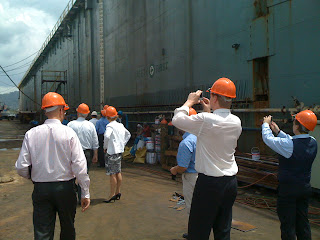During 6-8 July 2011, I was invited to share the experience in the interesting seminar in Holland. It was the 2-day programs where colleagues from all over the world gathered to share their comment and market knowledge on the launching plan of new product. Also, we discussed several things related to market in each different countries.
 |
| There were also invited guests to our seminar to gain our knowledge as well. |
Thermaflex's new product has been invented from the idea that plastic insulation is less flexible than rubber insulation. Its "Lambda Value" is more stable than rubber (rubber tends to have higher (worse) lambda value with more thickness). This is the newly innovative product which is not "Pure PE" anymore. People always think of our product as "PE Insulation", but now we call our new product line as "Polyolefin (PO) Insulation".
Talking about Polyolefin, you need to take a look at the family of plastic. Polyolefin is like the main category where it has its sub-category as PE, PP, PVC, and so on. This is the newly developed formula where Thermaflex has reached its first real flexible insulation to supply to the market, yet still maintain its high quality. The R&D of Thermaflex Holland has boasted to reach Class 0 with this new product. At the moment, it's under the production test run and test certificate submission.
From this seminar, I have learned a lot, especially I have learned that most countries have a unique requirement from their customer. For example, in Russia they need to have the test called "Linear Material Shrinkage", which is the test of shrinkage at the temperature of 80 Celsius for several hours test period. This kind of test is not needed, or I can say it's not even recognized in most of Asian region.
Another similar idea of unique requirement is for market in Australia, where they always refer to the insulation property by using "R Value". Again, this R-Value is not something we are interested in Asia, but Lambda value is more important to customers in Asia.
There is a "funny" info that I learned from this seminar, which I will tell you later. However, this funny info relates to the basic knowledge of SCC (Stress Corrosion Cracking).
SCC is the serious issue when the insulation is not installed correctly. It's related to the moisture that will penetrate into the layer of insulation and pipe. However, the 'fastest corrosion' is found in the "Nitrile Rubber Insulation"( not EPDM Rubber Insulation). This is due to the blowing agent of Nitrile Rubber consist of Ammoniac, which will react to the moisture, and stimulate faster SCC. After installing for long time there is a chance that moisture could leak into the joint of insulation. The moisture will then have a reaction with the ammoniac in Nitrile Rubber, which eventually will cause SCC. After all, the correct installation is very important.
The funny thing I heard from this seminar is that one of the rubber insulation suppliers claims that their product has "SCC Indicator" property. They said with their product the SCC can be detected by bare eyes. That is when there is a "swell" of insulation surface.
Well, the rubber insulation of any kind (either nitrile or EPDM) has a very high Water Vapour Diffusion ( µ-value), but the fact is that they can reach such high value due to their 'skin'. If skin is scratched, then µ-value will be gone. Their inner layer is not 100% closed cell structure, unlike PE or Polyolefin product.
You can do the comparison test easily by cut the same size of both Rubber and PE insulation samples (any PE insulation would be OK) into the bucket of water for a week. Before you put into the water, weighing each sample weight (at the same size, you will notice PE has less weight than Rubber which is due to the difference in density). After a week, you weighing again both samples' weight. You will then see the difference. You will see which one absorb water!
There are also more interesting points from this seminar about our product, test certificate, and competitors. Let me continue this later.
Cheers!










































